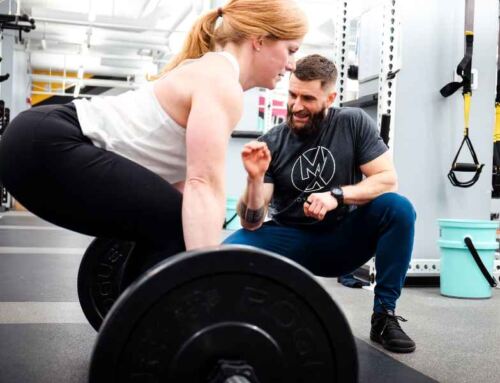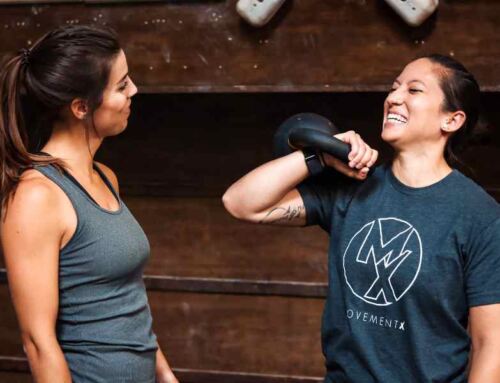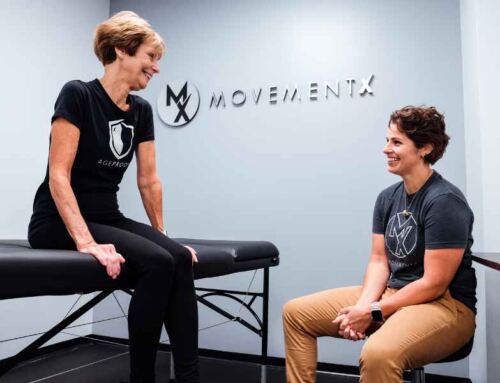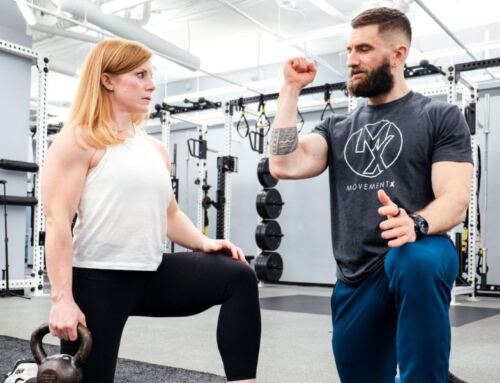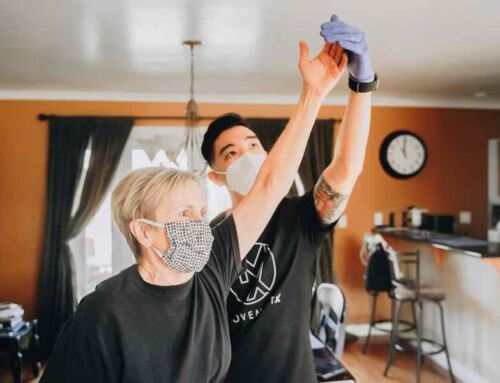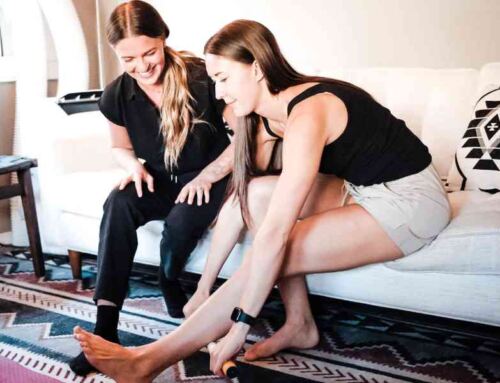Get a Grip!
How to improve grip strength so you can lead a longer, healthier life
Imagine this. You come home from a long day at the office, hungry and tired, and head to the fridge to reach for your favorite snack – a jar of pickles. Your mouth begins to water as you think about the salty, sweet crispy crunch of briny cucumber. As your hands grasp the glass vessel, you brace yourself, fingers latching on to the lid and TWIST!
But no movement.
A moment of disbelief waves over you and you try AGAIN.
No budge.
You whisper to yourself, “third time’s the charm” and try once more – a single bead of sweat rolls down your temple, your forearms pump and a flash of panic ensues – you are feeling defeated. Pickles go back into the fridge, uneaten, and you settle begrudgingly for a pre-opened bag of chips instead and mutter “I gotta work on my grip strength”

Why Is Grip Strength Important?
While opening a jar of pickles is not a life or death situation, failing to recognize the importance of maintaining strong fingers, hands and forearms as we age is imperative. Why? Having poor grip strength has been found to be a strong predictive biomarker of many specific health outcomes such as cardiometabolic disease, generalized strength, cognition, functional independence and overall mortality (Bohannon 2019)
A 2022 study published in BMC Medicine analyzed data from nearly 500,000 participants over 12 years, revealing that individuals with the weakest grip strength were on average 1.56x more likely to develop cardiometabolic disease compared to those with the strongest grip strength (Lu et al 2022). Another study looked at the relationship between hand grip strength and risk for fall in older women – showing that those with below average grip strength had a 3-fold increased risk for falling (Neri et al 2021). Results from these studies underscore the profound impact grip strength can have on overall health and longevity, serving as a stark reminder of its importance beyond just having a firm handshake.
Aside from being a strong indicator of longevity, grip strength impacts nearly all other aspects of physical fitness and wellbeing, including:
- Daily Activities of Living: Grip strength is crucial for performing tasks like carrying groceries, opening jars, or lifting objects.
- Athletic Performance: Many sports rely on grip strength for success. Whether it’s tennis, weightlifting, rock climbing or martial arts, having a strong grip is the foundation for athletic activity.
- Injury Prevention: A strong grip helps maintain proper form during physical activity, reducing the risk of injuries to the hands, wrists, and forearms. Additionally, reactive grip can help prevent falls, allowing your upper extremities to support your body during a slip or misstep.
- Bone Health: Regularly engaging in grip-strengthening exercises can promote bone density, especially in the hands and wrists, which are prone to osteoporosis.
- Functional Independence: As we age, maintaining grip strength becomes even more critical for independence and quality of life. A strong grip can help us perform daily activities and reduce the risk of falls.
How To Test Your Grip Strength
The best way to test your hand grip strength is with a device called a handheld dynamometer. There are both digital and hydraulic versions that can be used to test your grip, the latter being the gold standard. To perform the test, you will hold the dynamometer in one hand with your wrist in neutral and your elbow bent to 90 degrees. Slowly squeeze the handle (it will not move) as hard as you can – the amount of static force generated by the squeeze will be measured in lbs or kg. You will take the test 3 times and then take the average of all three.
While you can purchase your own dynamometer and test yourself, a physical therapist will be the best provider to deliver this assessment as well as provide you with the best ways to improve your grip strength.
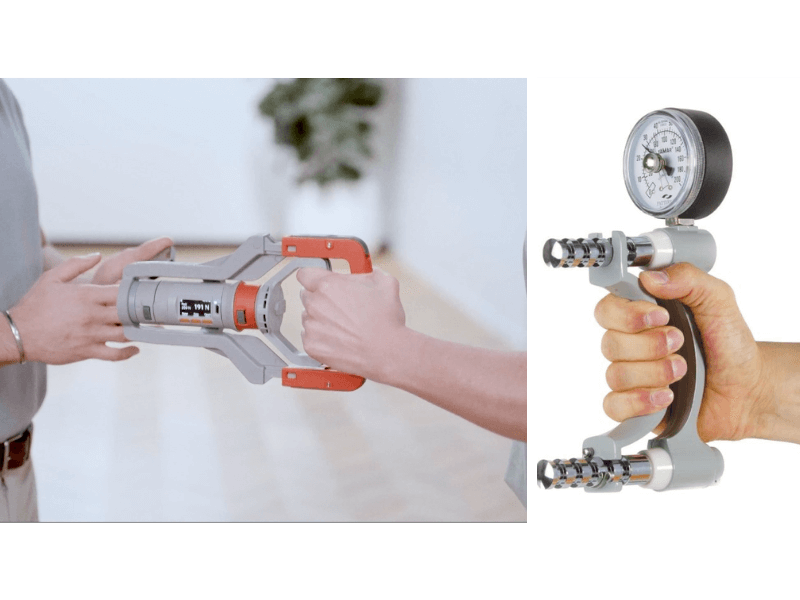
Curious how you stack up against those of your age and gender? Here is the normative grip strength data for adults. Note: your dominant side is likely to test 10-15% stronger than your non-dominant side.
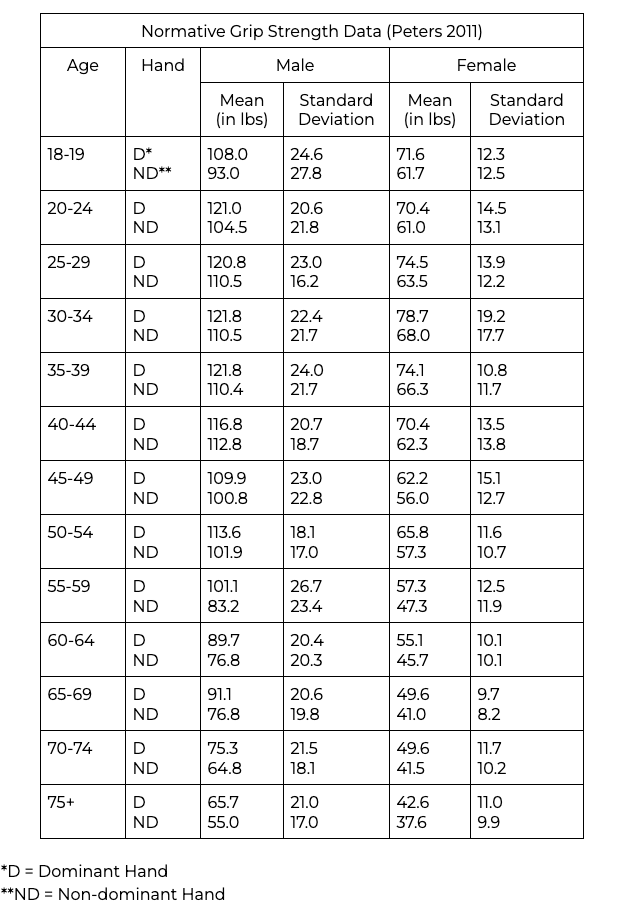
3 Ways to Improve Your Grip Strength
While it is often overlooked, grip strength training holds the key to maintaining your autonomy, ensuring that you can continue to live your life without limitations into old age. Improving grip strength can be done through various exercises, including wrist curls, heavy weight lifting, and using grip strength training tools like hand grippers or stress balls.
Here are my TOP THREE WAYS* to improve your overall grip strength that can be scaled to your ability.
1 — Farmer Carries
Pick up something heavy and walk around with it!
What does it do?
Works on your support grip, strengthening your hand intrinsic muscles, forearms, shoulder cuff and core.
How To Do It:
- Take a heavy kettlebell, dumbbell or even a suitcase full of books or clothes and place it by your side.
- Squat down, grab the handle and engage your shoulder blades and core as you stand up. Holding the weight, start walking or pacing in place for 60 seconds. Make sure you are not leaning to one side.
- Perform the same exercise on the other side and repeat 2-3x per side with 60 seconds rest between.
How To Scale It:
- Scale it Down: Depending on your current activity level, 15-20% of your body weight is a good place to start. Slowly increase the challenge over time by working up to 50% of your body weight.
- Scale it Up: Try training a double sided farmer’s carry by holding equal weights in both hands as you walk. Add stairs or different types of terrain to spice it up. Imagine carrying all your groceries in one trip!
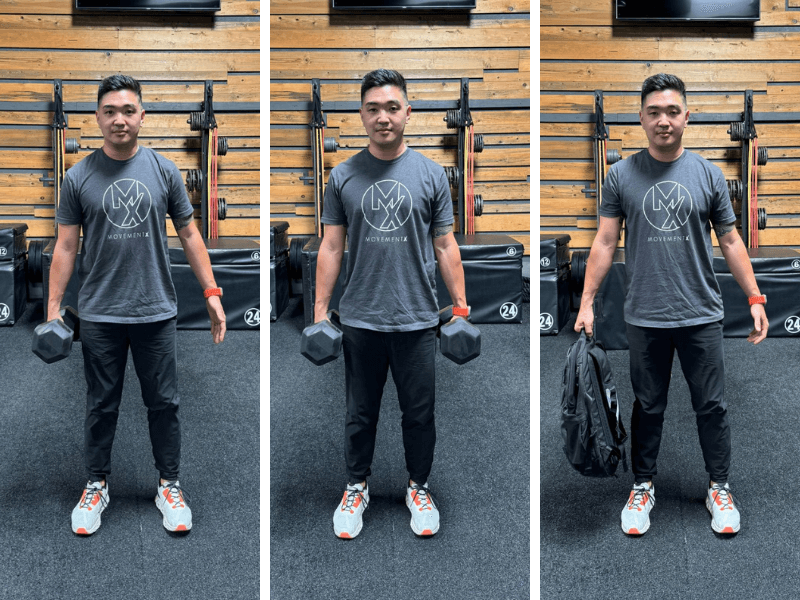
2 — Bar Hangs
Hang from a pull-up bar as long as you can.
What does it do?
Works on your overhead grip strength and helps to develop finger and forearm strength. It is also a great way to improve your shoulder mobility!
How To Do It:
- Stand under a pull-up bar and grasp the bar with your hands at about shoulder width apart – palms facing forward to start. Avoid over-squeezing the bar. Keep your neck relaxed and engage your shoulder blades and core while still being about to breath.
- Lift your feet and allow your weight to be supported by your hands. Hold for as long as you can!
How To Scale + Other Variations:
- Scale it down: Place a stool under your feet for support so that you can stand up and grasp the bar. Slightly bend your knees to offweight your body and hold the bar for bouts of 1 minute, using your feet for touch support as needed. As you improve, you will need to use your feet less!
- Scale it Up #1: Place two hand towels over the bar and grasp the ends with either hand. Hang while holding the towels – your hands and wrists will now have more freedom to move but also be challenged in a different way.
- Scale it Up #2: Switch grips by having your palms face you (like a chin-up) or try one hand palm facing forward and one palm facing backward!
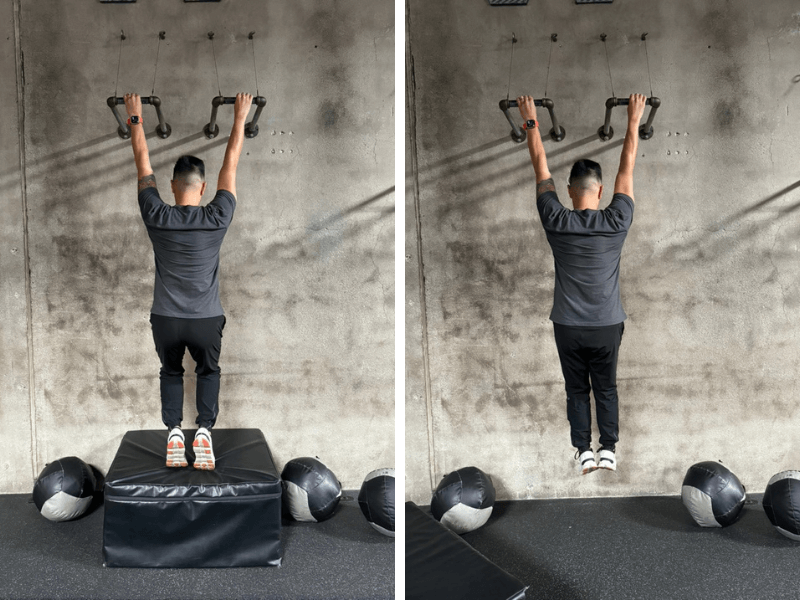
3 — Plate Pinches
Hold a weight or a heavy book between your thumb and fingers like you are holding a sandwich and walk around without dropping it.
What does it do?
This works your hand’s intrinsic muscles called the lumbricals as well as the primary opposition muscles of the thumb. This is important because not all objects you need to hold onto are going to be shaped conveniently like a bar!
How To Do It:
- Grab barbell plates of various sizes and widths. Prop one up on its side and grasp the edge of the plate with your hand – thumb opposing the other four fingers like you are grabbing a sandwich.
- Squeeze and lift the weight to your side and hold as long as you can.
How To Scale It:
- Scale it Down: Instead of using barbell weights, find several text books of various weights and widths (does anyone still have the yellow pages?). You can also stack the books for a wider grip.
- Scale it Up: Next try pinching the plate or book and doing a curl, row or simply holding it out in front of you for a big core challenge!
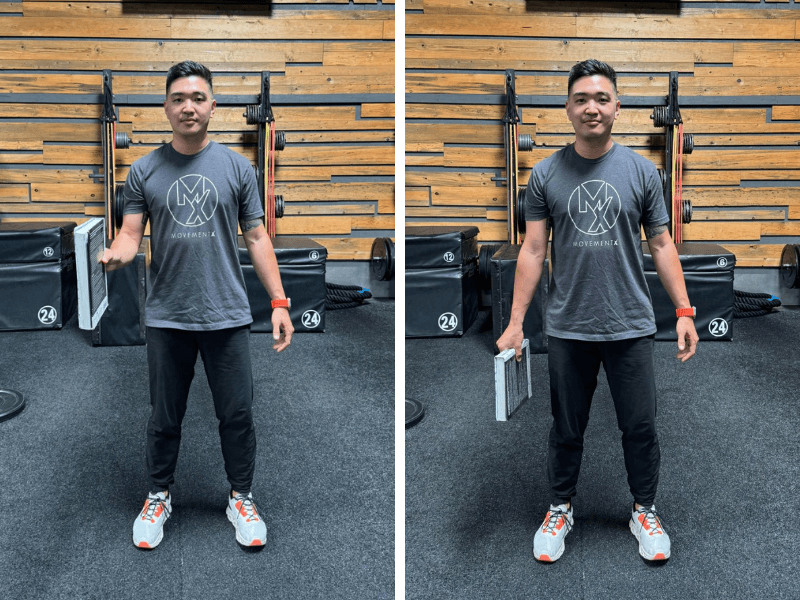
Disclaimer: if you are currently injured or are unsure of how to perform the following exercises safely, please reach out to a physical therapist who can assess and determine the appropriate modifications.
Conclusion
Remember, having weak grip strength is not just a matter of inconvenience; it’s the difference between independence and reliance across your lifespace. Whether your goal is to climb to the top of a mountain or pick up your grandchildren without pain, developing a strong grip as we age is an absolute necessity. The best part about training grip strength is that it can be achieved with simple movements as well as combined with other compound exercises you may already be doing!
Are you ready to get a grip on your life? The first step is to get a baseline measurement from a healthcare professional such as a physical therapist. Our team is equipped with industry standard equipment to accurately measure and track your progress. Connect with a MovementX Physical Therapist to get started today!
References
- Bohannon RW. Grip Strength: An Indispensable Biomarker For Older Adults. Clin Interv Aging. 2019 Oct 1;14:1681-1691. doi: 10.2147/CIA.S194543. PMID: 31631989; PMCID: PMC6778477. https://www.ncbi.nlm.nih.gov/pmc/articles/PMC6778477/
- Lu, Y., Li, G., Ferrari, P. et al. Associations of handgrip strength with morbidity and all-cause mortality of cardiometabolic multimorbidity. BMC Med 20, 191 (2022). https://doi.org/10.1186/s12916-022-02389-y
- Neri SGR, Lima RM, Ribeiro HS, Vainshelboim B. Poor handgrip strength determined clinically is associated with falls in older women. J Frailty Sarcopenia Falls. 2021 Jun 1;6(2):43-49. doi: 10.22540/JFSF-06-043. PMID: 34131600; PMCID: PMC8173535. https://www.ncbi.nlm.nih.gov/pmc/articles/PMC8173535/
- Peters MJ, van Nes SI, Vanhoutte EK, Bakkers M, van Doorn PA, Merkies IS, Faber CG; PeriNomS Study group. Revised normative values for grip strength with the Jamar dynamometer. J Peripher Nerv Syst. 2011 Mar;16(1):47-50. doi: 10.1111/j.1529-8027.2011.00318.x. PMID: 21504502. https://pubmed.ncbi.nlm.nih.gov/21504502/
About the Author
Dr. John Huang is a physical therapist based in Orange County, CA. He is extensively trained in Movement System Impairments (MSI) and also treats orthopedic conditions, post-operative care, sports injuries, and neurological conditions. John Huang is certified as a Senior Fitness Specialist, Certified Nutrition Coach, Vestibular & Concussion Rehab Specialist, and more. Away from his practice, John is a professional DJ and loves to get people moving with the power of music.



